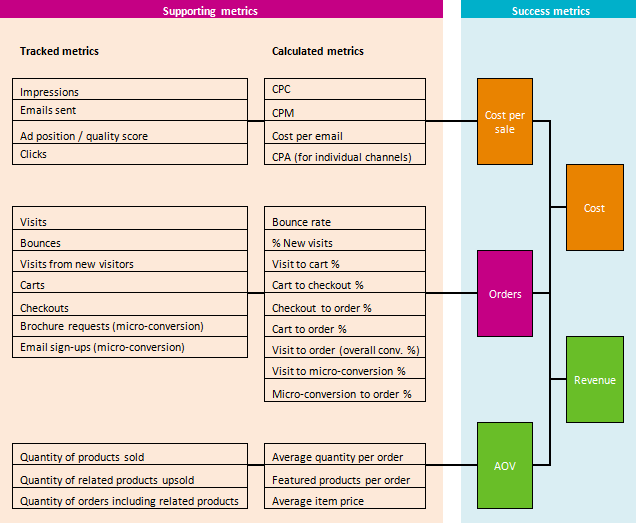Mapping Objectives to Metrics

Through the first two posts of this performance measurement and optimisation series, we have now clearly defined the business objectives and identified all primary and secondary conversion points on the website in question. This post will cover the process of translating (or mapping) the defined objectives into relevant metrics, against which progress can be measured and analysed.
To demonstrate the process, we will take one set of the example objectives from the first post:
Long-term objectives
Double revenue in the next two years
Medium-term objectives
Increase average order value (AOV) by 50%
Short-term objectives
Introduce 'related products' feature on the website
With this set of business objectives in mind, we can begin to select the appropriate metrics to measure ongoing performance against.
First we need to clarify these objectives a little further and provide some necessary context. Without clarity, it is difficult to quantify performance and very easy to lose perspective.
Assumption 1: Revenue for the financial year 2011/2012 was £100k.
Therefore, revenue for the year ending 2013/2014 needs to be £200k to hit the example long-term objective.
Assumption 2: Growth needs to be developed economically, therefore cost related metrics are equally important.
Assumption 3: The reason we are looking to increase AOV by 50% is because (a) this will be cheaper than driving double the number of customers and (b) this would be easier to achieve within this particular market due to the level of competition (i.e. the additional revenue cannot all come from gaining further market share).
Therefore, it is not simply a case of increasing advertising spend to inflate turnover; we want to achieve this growth as efficiently as possible, maintaining a target CPA.
Based on what we know, it is immediately clear that the key metrics we will be interested in will broadly relate to revenue and cost. However, each of these key metrics can be broken down further into their core components. In addition to this, we will also want to define and monitor a range of supporting metrics which can affect our two primary (or success) metrics over time.
We are now in position to start writing down a comprehensive list of metrics which will be of interest in relation to our example objectives.
Success metrics
Revenue
- Orders
- Average order value (AOV)
Cost
- Orders
- Cost per sale (CPS)
Note: 'Orders' is duplicated above as both key success metrics in this example are dependent on the number of orders generated.
The next step is to work backwards from these success metrics in order to identify the supporting metrics which can affect either the revenue or the cost.
Supporting metrics
Revenue
- Visits
- Bounces
- Visits from new visitors
- Carts
- Checkouts
- Brochure requests (micro-conversion)
- Email sign-ups (micro-conversion)
- Quantity of products sold
- Quantity of related products upsold*
- Quantity orders including related products
*This is important as a related products feature is being introduced to the checkout process to enhance AOV.
Note: Not all metrics above are certain to influence revenue (e.g. micro-conversions) but it is important to monitor as much as possible initially to gain a better understanding of what will affect performance. As mentioned in the previous post, micro-conversions can lead to subsequent macro-conversions (in this case, orders).
Capturing the metrics above will then allow us to calculate the following:
- Bounce rate
- % New visits
- Visit to cart %
- Cart to checkout %
- Checkout to order %
- Cart to order %
- Visit to order (overall conversion %)
- Visit to mico-conversion %
- Micro-conversion to order %
- Average quantity per order
- Featured products per order
- Average item price
Some of the calculated metrics above could be used to form KPIs further into this process as they can all heavily impact revenue performance.
Cost
- Impressions
- Emails sent
- Ad position / quality score
- Clicks
- CPC
- CPM
- Cost per email
- CPA (for individual channels)
Once the list is compiled, it can be mapped to show the relationship between the supporting metrics and the overall success metrics (as below). This will be useful when it comes to designing and implementing a suitable analytics solution and also further down the line when analysing and optimising performance.

For the sake of simplicity, the map above does not feature a definitive list. There are many other supporting metrics which could be factored in such as the number of ‘recommend to a friend’ conversions, survey satisfaction scores, etc. The complete list will vary from business and business. As previously mentioned, it is important to set out to capture as many key metrics as possible initially in order to understand which particular factors affect the success metrics. During the dashboard and report creation phase (to follow later in this series), the metrics list can be further refined and distilled into executive formats.
Knowing the core metrics of interest and mapping these to our business objectives allows us to move onto the next stage in the process: audience segmentation. It is important not to treat all visitors as equal as the behaviour of different audience segments will differ. Therefore, their contribution towards our success metrics will also differ and this needs to be measured and understood. Hence, before moving onto the implementation of an analytics solution, it is important to split the target audience into suitable segments. This will be covered in the next post in this series.